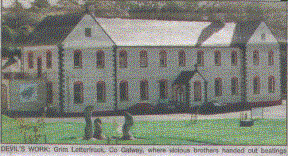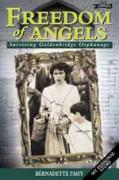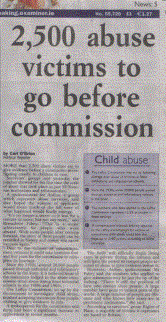The Reformatory Schools Act certified existing voluntary institutions and religious organisations to care for juvenile offenders with public funding and inspection
1868- The Industrial Schools Act. Industrial schools were established to care for “neglected, orphaned and abandoned children.” They were run by religious orders and funded by the public.
1900- Peak of industrial schools with 8,000 children in 71 schools.
1908- The Children Act defined reformatories as responsible for feeding, clothing, housing and teaching young offenders and instigated annual visits by an Inspector of Reformatory and Industrial Schools.
1919- The revolutionary Dáil established by Sinn Fein declares “It shall be the first duty of the Republic to make provision for the physical, mental and spiritual well-being of the children,” but doesn’t suggest an alternative to the British industrial schools.
1920- Six counties partitioned under the Northern Ireland Act.
1922- New Dáil and Seanad established under the Irish Free State Constitution.
1924- The new State’s Department of Education noted that there were more children in industrial schools in the Irish Free State than in all of the United Kingdom.
1929- The Children Act allowed destitute children to be sent to industrial schools, even if they hadn’t committed a crime.
1933- Rules governing industrial schools were updated and funding increased.
1933- The Commission of Inquiry Into Widows’ and Orphans’ Pensions found only 350 of the children in industrial schools were orphans (5.3 % of the total)
1933- Industrial schools were abolished in the UK, but not in Ireland.
1934- The Cussen Report, which investigated industrial schools, had reservations about the large number of children in care, the inadequate nature of their education, lack of local support and the stigma attached to the schools, but concluded that “ schools should remain under the management of the religious orders”.
1937- Under a new Constitution the State guaranteed to protect “the inalienable and imprescriptible rights” of the family.
1941 —The Children Act increased State funding for industrial schools.
1943- St. Josephs Industrial School in Cavan, run by the Order of Poor Clares, burnt to the ground, killing 35 girls and one elderly woman. The nuns were exonerated in the subsequent inquiry.
1944- P. Ó Muircheartaigh, the Inspector of Industrial and Reformatory Schools reported that “the children are not properly fed,” which was “a serious indictment of the system of industrial schools run by nuns-a state of affairs that shouldn’t be tolerated in a Christian community” where there was “semi-starvation and lack of proper care and attention.” The Resident Managers of Lenaboy and Cappoquin industrial schools, both Sisters of Mercy, were dismissed for negligence and misappropriating funds, despite Church resistance. However, there were no other changes to industrial schools.
1945- The Department of Education agreed to pay industrial school teachers directly at the same rate as National School teachers.
1945- Secretary to the Department of Education wrote to the Secretary of the Dept. of Finance to denounce the “grave situation which has arisen regarding the feeding and clothing of children in industrial schools” due to “parsimony and criminal negligence”.
1945- Funding to industrial schools tripled.
1946- Rules governing industrial schools were updated and funding increased.
1946- Community pressure in Limerick, led by Councillor Martin McGuire, on the Dept. of Ed forces the release of Gerard Fogarty, 14, from Glin Industrial School after he was flogged naked with a cat of nine tails and immersed in salt water for trying to escape to his mother. A call for public inquiry into industrial schools was rejected by Minister of Education. Thomas Derrig because “it would serve no useful purpose”.
1946- Fr. Flanagan, famous founder of Boystown schools for orphans and delinquents in the US, visits Irish industrial schools. He describes them as “a national disgrace,” leading to a public debate in the Daíl and media. State and Church pressure forces him to leave Ireland.
1947- Three-year-old Michael McQualter scalded to death in a hot bath in Kyran’s Industrial School. Inquiry found school to be “criminally negligent,” but the case was not pursued by the Dept. of Education.
1948- Fr. Flanagan died of a heart attack and with him, the debate on industrial schools.
1949- Ireland declared itself the Irish Republic.
1949- Minister of Education General Mulcahey received complaints from Cork City Council about Greenmount IS. A visit is arranged (with advanced warning) and the case is dismissed.
1951- State Inspector denounced conditions of industrial schools and care of children.
1951- The Catholic Hierarchy condemned the ‘Mother and Child’ scheme (4 April), which provided direct funding to expectant mothers for their children; Dr Noel Browne, Minister for Health, resigns; the scheme was abandoned on 6 April.
1951- Standoff between Church and State when Church refused to provide financial records of how it has used funding in industrial schools in exchange for increased state funding.
1952- State funding to industrial schools increased.
1954- Daíl debate on Michael Flanagan, whose arm was broken while in care in Artane Industrial School. The case was dismissed as “an isolated incident”.
1955- Secretary of the Department of Education visited Daingean Industrial School, Offaly, and found that “the cows are better fed than the boys.” Nothing was done for another 16 years.
1957- Marlborough House building was condemned by the Dept. of Works as “a grave risk of loss of life.” No alterations were made, and it continued unchanged for 15 years.
1959- Minister of Education Jack Lynch received complaints about Upton School from Senator Gus Healy, the mayor of Cork. A visit was arranged (with advance warning) and the case was dismissed.
1960- Gardaí informed Archbishop McQuaid that Fr. Paul McGennis had developed pornographic films in England of children in his care in Our Lady’s Hospital for Sick Children. McQuaid arranged for McGennis to “have treatment which was considered successful at the time” Fr. McGennis was convicted in 1997 of molesting girls in his care in Crumlin Hospital in the 1960’s.
1962- Fr. Moore, Chaplain at Artane Industrial School, complained about the abuse received by the boys in the school. The State dismissed his allegations as an exaggeration.
1963- The Bundoran Incident. Eight girls trying to escape from St. Martha’s Industrial Schooll had their heads shaved. It became a scandal when it was front-page news in a British tabloid with photos and headline, “Orphanage Horror”. A Department. of Education official visited the Mother Superior of the school to tell her “The Department was unlikely to do anything of a disciplinary nature”.
The Glin Affair. Department of Education investigated a boy who was hospitalised upon receiving facial injuries in Glin Industrial School from a Christian Brother. No action was taken.
1967- Department of Health visit Ferryhouse Industrial School, Clonmel to investigate the death of a child from meningitis. They described conditions as “a social malaise” and recommended the closure of the school.
1969- Under 2,000 children were in 29 schools. Artane Industrial School was closed.
1970- The Kennedy Report recommended closure of industrial schools, as Justice Kennedy was “appalled” by the “Dickensian and deplorable state” of industrial schools.
1971- Catholic Church in Ireland held a seminar on child care. Sr. Stanislaus Kennedy defended the role of the Church in industrial schools.
1972 —Marlborough House, Dublin closed down.
1974- Letterfrack Industrial School closed down.

1974 —Daingean Industrial School, Offaly closed down.
1976- RTE broadcasted a tribute to Bro. Joseph O’Connor, founder of the Artane Boys Band. He was subsequently proved to be a multiple rapist of boys in Artane Industrial School.
1978- A child care worker at Madonna House kidnapped a boy in his care, took him to Edinburgh and drowned him in a bath in a hotel. The Minister for Health, Charles Haughey, rejected a call for a public enquiry into the matter, stating that it “would serve no useful purpose.”
1980- A Task Force on child care services emphasised the need for child care staff training, care for children after leaving institutions and family support.
1984- Payment-per-head funding for children in care in Ireland was abolished.
1984- Department of Health introduced fostering for children in care.
1985- Children of the Poor Clares by Mavis Arnold and Heather Laskey published.
1989- The Children Act gave health boards powers to care for children.
 1989- The God Squad by Paddy Doyle published.
1989- The God Squad by Paddy Doyle published.
1991- The Child Care Act gave powers to health boards to care for children who were ill-treated, neglected or sexually abused.
1991- Fear of the Collar by Patrick Touher published 
1996- A conviction for sexual abuse by a worker in Trudder House, Co. Wicklow, where he worked with Traveller children throughout the 80’s.
1996- The Madonna House Report detailed continuing physical and sexual abuse of children in State and Church care. The report was suppressed by the government.
 1996- Willie Delaney’s body was exhumed to investigate whether beating was the cause of the 13-year-old’ s death in 1970 while in care at Letterfrack Industrial School. The results were inconclusive.
1996- Willie Delaney’s body was exhumed to investigate whether beating was the cause of the 13-year-old’ s death in 1970 while in care at Letterfrack Industrial School. The results were inconclusive.
1997 —Dear Daughter was broadcast on RTE. Christine Buckley’s description of her abuse while under care in Goldenbridge sparks public debate on industrial schools.
1998- The Christian Brothers in Ireland make a public apology to those who were physically or sexually abused in their care.
1999- States of Fear by Mary Raftery and Eoin O’Sullivan was broadcast on RTE in April and May, renewing debate on industrial schools
1999 —Suffer the Little Children by Mary Raftery and Eoin O’Sullivan published
 1999- Freedom of Angels by Bernadette Fahy published
1999- Freedom of Angels by Bernadette Fahy published
1999- An Taoiseach Bertie Ahern apologised on behalf of the government to the victims of child abuse in industrial schools, acknowledging the responsibility of the Irish State in providing services for children. A Commission to Inquire Into Childhood Abuse was established under Justice Laffoy, which became official under the Child Abuse Act, 2000
2000- The Child Abuse Act established a commission to investigate child abuse in institutions in the State, and to enable persons to give evidence to committees of the Commission.
2000- Focus Ireland publication, Left Out On Their Own, reported serious deficiencies in residential care. They found 75% of those leaving Health Board Care experience homelessness within the first two years of leaving.
2001- Catholic Church agreed to pay over £100 million into a special State fund for victims of abuse. In return, the State arranged that people seeking compensation from the Residential Institutions Redress Board are barred from suing the Church directly. Only victims of sexual, not physical, abuse are eligible for compensation.
5 days later, Justice Kelly described the juvenile justice system as “a shambles and chaotic” after being forced to send a disturbed and neglected child into a psychiatric hospital, due to lack of alternative accommodation.
2002 – An independent inquiry condemned conditions in Finglas Children’s Home, and recommended either change or closure. Arson attack on school.
History of Neglect Timeline 1858-2002
[ Click on each image to enlarge. For slideshow hover mouse over side of image to click image going forward and backwards. These are large images! ]
 The number of children committed to industrial schools by the Courts steadily declined from 833 at the time that the Irish Republic was declared in 1949 to merely 162 in 1968-69, when the industrial schools began to be closed down.
The number of children committed to industrial schools by the Courts steadily declined from 833 at the time that the Irish Republic was declared in 1949 to merely 162 in 1968-69, when the industrial schools began to be closed down.


Table
[The table, from 1949-1969, is divided into three images. Click on each image to enlarge. For slideshow hover mouse over side of image to click image going forward and backwards]



The overwhelming cause of committal was “lack of proper guardianship.” Only a small number were committed for inadequate school attendance, indictable offences and homelessness.
Sources: Suffer the Little Children( by Mary Raftery and Eoin O’Sullivan); This Great Little Nation (Gene Kerrigan and Pat Brennan); Ireland Politics and Society, 1912-1985 (Joseph Lee); Ireland Since the Famine (FS Lyons) Victim and Critic: Child Mistreatment in Ireland ( Mary Killion)
